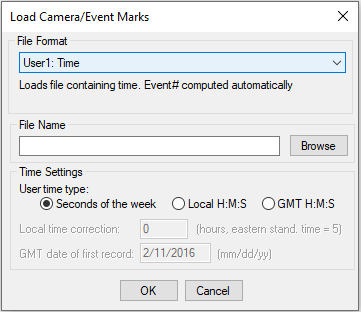Camera Event Marks
Events from supported GNSS formats are automatically written to a station file (.sta) during conversion of the raw GNSS data to GPB, and automatically loaded into the project and displayed on the map window.
Use the Load Camera/Event Marks feature to load external time-tagged events from an ASCII file from one of four supported input formats. When you load events, they must be referenced to GPS time, local H:M:S or GMT H:M:S. The source of the events can come from an aerial camera, sounding equipment or other real-time devices.
How to load camera event marks

-
Under File, select Load | Camera Event Marks.
-
Choose the file format that matches your input file.
-
Under File Name, use the Browse button to select the input file.
When features/camera marks have been loaded into a project, they appear as bright blue circles on the map window. If no event marks are present after processing, first check that you have not disabled the display of event marks within the General Map Options of the Display tab within File | Preferences. If Feature marks is enabled, it is likely that the time tags are wrong or no event marks have been loaded. To determine what has been loaded, use the Feature Editor by selecting View | Features.
File Format
STA File
Most supported receiver formats write features/camera marks directly to the station file. The features load when you add the GPB file to the project. In the event you have deleted features using the Feature Editor and you wish to re-load the original station file, use the File | Load | Station File feature.
User#
These formats allow you to import the time and name of each event mark. Optional variables include line number (description) and altitude information.
Time settings
User time type:
Seconds of the week – GPS time ranging from 0 to 604800.
Local H:M:S – Local hours, minutes and seconds (HH:MM:SS.SSSS) in GPS time scale.
GMT H:M:S – GMT hours, minutes and seconds (HH:MM:SS.SSSS) in GPS time scale.
Local time correction:
This is necessary for both Leica and User# formats using Local H:M:S. This is the offset, in hours, from GMT. For the Eastern Standard Time zone, this number is 5. For the Pacific Standard Time zone, this number is 8. During daylight savings time, these numbers are reduced by one. An incorrect entry causes the camera marks to be displayed incorrectly or not be displayed at all.
GMT date of first record:
This is necessary for Leica, Ashtech and User# formats implementing H:M:S time-tagging. Enter the date of the first exposure record in month/day/year format. It is not the date in local time, which may differ towards the end of the day. An invalid date results in the marks not being displayed.